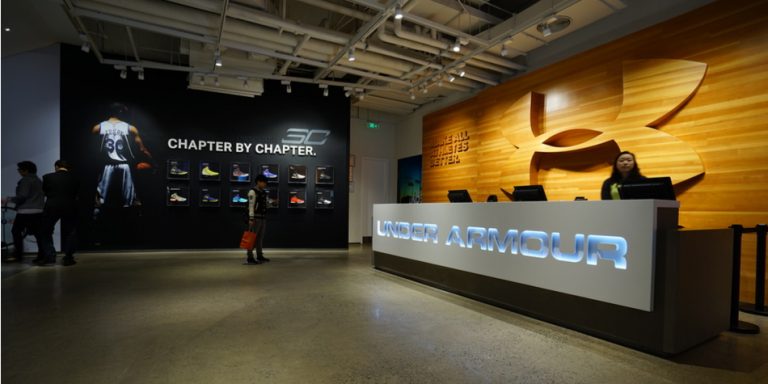Shares of Under Armour (NYSE:UAA) traded significantly higher in mid-May on a bullish note from JP Morgan, who upgraded Under Armour stock to Overweight with a $29 price target, implying ~30% upside over the next twelve months.

The bull thesis from JP Morgan is pretty simple. Under Armour has struggled significantly over the past several years with its product assortment and that has led to building inventories amid stagnant sales.
In order to clear that inventory, Under Armour has had to run deep discounts on its merchandise, sell into lower-priced channels, and slow new product roll-out. Those moves stabilized sales, but they also diluted brand equity and dragged on margins. Net result? Profits were wiped out.
Inventory levels are dropping fast and now sit at their lowest level in several years. Management thinks this “down-sizing” era is over. Inventory levels are now appropriately low. Discounting will stop. Lower-priced sell-through will stop, too. The company can now put out new premium product, which should lift brand equity and margins. Net result? Profits should come soaring back.
Consequently, while Under Armour is still in the early stages of this pivot, JP Morgan thinks now is the time to buy into Under Armour stock.
But, this argument misses two critical risks: competition and valuation. Ultimately, those two risks will cap near to medium term upside in Under Armour stock.
Competition Risks Are Sizable
Broadly speaking, the big growth niche in the athletic apparel space is in the convergence of athletic and leisure styles, and Under Armour has failed to keep pace with peers on the athleisure front.
The rise of the internet and specifically visual-first social media has made consumers more aware of their image, health, and fitness than ever before. Consequently, consumers are increasingly trying to lead more healthy and fit lifestyles, and a big part of the image associated with that lifestyle is wearing athletic-style clothes that are simultaneously comfortable and can be worn anywhere, all the time. The fix? Athleisure styles.
Under Armour completely missed the boat on this athleisure trend and continues to miss it today. While brands like Nike (NYSE:NKE), Adidas (OTCMKTS:ADDYY), and Lululemon (NASDAQ:LULU) really focused on becoming lifestyle brands with a product assortment that applies to all consumers, Under Armour has consistently doubled down on performance. That was the wrong move.
Consequently, while the other three players have consistently grown at a double-digit rate over the past few quarters, Under Armour’s growth has fallen flat.
Falling inventories won’t solve that problem. Sure, now Under Armour can roll out new premium product and stop discounting stuff, which will help margins. But the company also needs to fix its image by becoming more of a lifestyle brand. As of today, it doesn’t seem like there is anything in the growth pipeline which will do that.
Further, even if Under Armour does pivot into lifestyle, they have a lot of catching up to do. Nike, Lululemon, and Adidas are firing on all cylinders right now, and all three are only gaining momentum. Under Armour will have a tough time gaining share against that backdrop.
Valuation Risks Cap Upside
Considering the competitive backdrop and Under Armour’s recent inability to gain share in that competitive landscape, today’s valuation on Under Armour stock seems stretched.
Under Armour stock trades at nearly 60-times forward earnings. Everyone else in this industry trades roughly between 20- and 35-times forward earnings and everyone else is growing much more quickly. As such, relative to current growth rates, Under Armour’s 60 forward multiple seems absurd.
Sure, the bulls keep touting the long term profit growth potential. Yes, this company does sit at low single digit operating margins, versus mid-teens operating margins over at Nike. Thus, if the company does fix its inventory and discount problems, margins have lots of runway to move higher, and that will provide fuel for robust profit growth.
But, if you model all that out, the valuation still seems stretched. Realistically, the global athletic apparel market will grow at a 4-6% annualized pace over the next several years. Best case scenario, Under Armour maintains share in that market.
Thus, revenue growth runs around 5% per year. Operating margins move significantly higher to above 10% with inventories cleared and discounting in the rear-view mirror.
Under all those aggressive assumptions, Under Armour can realistically do about $1.50 in earnings per share by fiscal 2025. Based on a Nike-average 25x forward multiple, that implies a reasonable fiscal 2024 price target for UAA of $37.50. Using a 10% discount rate, that equates to a fiscal 2019 price target of just over $23.
Bottom Line on Under Armour Stock
Under Armour’s inventories are falling. That’s good. It means the company does have runway to stabilize growth over the next several years, and push margins significantly higher. But, all that news is already priced into the stock, and the growth narrative is still riddled with competition risks. Thus, near term upside in UAA stock seems capped at $25 by competition and valuation risks.
As of this writing, Luke Lango was long NKE and LULU.
